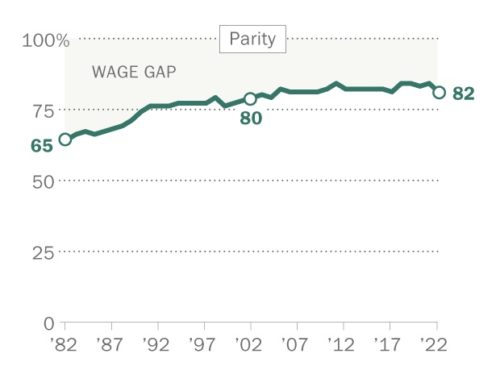Introduction: Poor outlook for children of unwed mothers
Much of what I have written derives directly from articles that cover this subject.
Over the past year, I have a number of conversations about the significant increase in out of wedlock pregnancy rates in the United States. The skyrocketing numbers should generate a national debate given that most of the children will be born into poverty with all of the attendant problems.
Children born to unmarried mothers are more likely to grow up in a single-parent household, experience unstable living arrangements, live in poverty, and have socio-emotional problems. As these children reach adolescence, they are more likely to have low educational attainment, engage in sex at a younger age, and have a birth outside of marriage. As young adults, children born outside of marriage are more likely to be idle (neither in school nor employed), have lower occupational status and income, and have more troubled marriages and more divorces than those born to married parents.
Background and Prospects of Unwed Mothers
Women who give birth outside of marriage tend to be more disadvantaged than their married counterparts, both before and after the birth. Unmarried mothers generally have lower incomes, lower education levels, and are more likely to be dependent on welfare assistance compared with married mothers. Women who have a nonmarital birth also tend to fare worse than childless single women; for example, they have reduced marriage prospects compared with single women without children.
Racial Profile
In 2013, 72 percent of all births to African American women, 66 percent to American Indian or Alaskan native women, and 53 percent to Hispanic women occurred outside of marriage, compared with 29 percent for white women, and 17 percent for Asian or Pacific Islander women. However, the difference between black and white women in the percentage of births that are nonmarital has been shrinking since 1980.
Age of Unwed Mothers
The age of unwed mothers is highly skewed toward the young. 99% of all women under the age of 15 are unwed. Close to 90% below the age of 20. More than six out of 10 women who give birth in their early 20s are unmarried, the Census Bureau said Wednesday in a report that shows sharp discrepancies in single mothers related to income, education and race.
Most of these unwed mothers have not even graduated from high school (57%) and thus do not have the job skills necessary to earn a middle class job in today’s environment.
Education Demarcation
The Census Bureau report said women with college degrees and higher household incomes are far less likely to be single mothers than are women who have lower household incomes and less education.
The biggest rise in unmarried pregnancy is among the 54 percent of “middle American” women, which include women who have graduated high school and completed some college but do not have a degree. Fifty-eight percent of the first births in this group are to unwed mothers
Percentage of Unwed Mothers
According to the Census Bureau, over 40% of all children born in the United States are to single mothers. The problem is escalating.
Unwed Mothers Geographic Dispersion
The rate of unwed mothers in the United States is significantly higher than other advanced countries. Some 7 times greater percentagewise than Switzerland.
Why does America have more unwed pregnancies than other nations?
Two reasons stand out. First, many Americans have strong views, often religiously inspired, about sex and abortion. Some consider IUDs to be abortifacients because they could prevent a fertilized egg from implanting in the uterus. Some also object to schools teaching about contraception.
Second, America is a litigious place. The penalties for doing something wrong are immense. The maker of Dalkon Shield, a defective IUD sold in the 1970s, was bankrupted by hundreds of thousands of lawsuits. Modern long-acting contraceptives are extremely safe, but manufacturers have been slow to market them in America and doctors have been hesitant to recommend them. Many women who would benefit from them do not know they exist, or imagine that they are dangerous.
Possible Solutions: Implants and IUDs: Taking the bother our of birth control
There is a terrible irony. Specifically, there are many more effective technologies available to women today than historically.
Teenagers are using contraceptives, but only 7% of those use more effective methods, which include hormonal implants (tiny rods inserted under the skin) and intrauterine devices (IUDs), according to data from publicly funded clinics in 2013 published by the Centers for Disease Control on April 10
Examples of Successes
Some states are promoting IUDs more vigorously than others. In Colorado in 2009 a private foundation started paying both for IUDs and implants in public clinics and for training the staff who provide them. Within two years teenage births fell by 26% and abortions by 34% (both were down in other age groups, too). Colorado saved over $6 for each dollar spent on the program—excluding the gains to women who finished high school instead of dropping out to care for a child. The state Senate is now mulling a bill to extend the program. Similar ones in Iowa and Missouri have also shown good results
Why the high pregnancy rates?
Four in ten unplanned pregnancies in America result from the slapdash use of contraception. Many of these could be averted by IUDs. Their failure rate is 0.2%, compared with 9% for the pill and 18% for condoms, the two most popular methods among teenagers. They work better because once they are inserted, you don’t have to think about them again. This means they are less fiddly than the pill, which a woman must remember to take every day, or the condom, which a man must put on when aroused and perhaps not thinking straight.
Implants and IUDs “change the default”, argues Isabel Sawhill in “Generation Unbound”. A woman who uses one is “virtually infertile until such time as she explicitly [chooses] to become a mother”. By contrast many women today, especially in poor families, drift into motherhood. In one survey 44% of young American women agreed that “It doesn’t matter whether you use birth control or not; when it is your time to get pregnant it will happen.”
Cost of long-acting contraceptives:
From the perspective of the nation as a whole or to the individuals involved, the cost of long-acting contraceptives is very cost effective.
Long-acting contraceptives cost more to begin with: $800-1,000 apiece. But they work out cheaper over time, since they last for three to ten years. They are covered by Medicaid, the public health scheme for the cash-strapped, but in some states the rules make it tricky for providers to get reimbursed. Since 2013 Obamacare has required private insurers to cover all FDA-approved contraceptives, with exemptions for old policies that have been grandfathered into the new system.
Knowledge Gap
The main obstacle is not cost but knowledge. A survey last year by the National Campaign to Prevent Teen and Unplanned Pregnancy found that 77% of Americans aged 18-45 knew “little or nothing” about implants; 68% said the same about IUDs (one in four do not know where the IUD goes). Misperceptions about safety and efficacy are common, too. Teenagers rarely ask for coils or implants.
Even medical providers are often unaware of guidelines that recommend IUDs and implants as the “first-line” methods for teenagers—meaning that providers should mention them first, before the less effective options. In 2011 a survey found that, in nearly half of publicly funded clinics that provide contraceptives, staff worried that IUDs might not be suitable for teenagers.
Many providers are not trained to insert IUDs and implants. This is especially the case among pediatricians, the doctors whom many teenagers approach first, and primary-care providers, who look after women in public clinics.
Historical Baggage
Some of the mistrust has stemmed from the debacle of the Dalkon Shield, a flawed IUD that caused some infections. It was pulled from the market in the 1970s and its maker was bankrupted by hundreds of thousands of lawsuits. The bad rap that created for the IUD lingered, even as devices became very safe.
America’s litigation record inhibits finding a solution
Both manufacturers and doctors are terrified of lawsuits in America. Contraceptives are especially likely to provoke them, since they are given to healthy people who, if they later fall ill, may call a lawyer. (This is also why obstetricians pay such sky-high malpractice-insurance rates—as much as $200,000 per doctor, per year in some parts of America.) Wary manufacturers of IUDs have been slow to push into the American market. But that is changing: there is now more advertising, new IUD brands are coming onto the market, and IUDs are becoming more popular.
Conclusion:
The economic and social cost of unwed mothers is placing an enormous burden on our society. In Sarasota, over 50% of school age children are food challenged. This has terrible ramifications for meeting their nutritional needs and undermines our education programs.
The problem is even more frustrating given that we have technological solutions to this problem. As a society, we need to embrace hormonal implants (tiny rods inserted under the skin) and intrauterine devices (IUDs).



